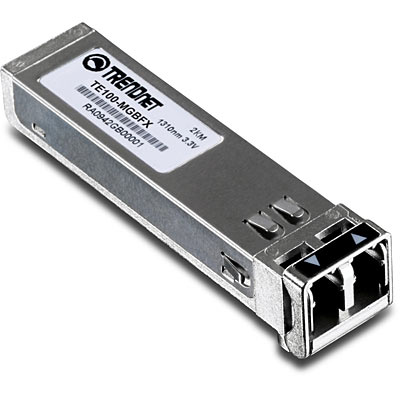Mini Gbic Patch Cable

Fiber Gbic
Specifications Manufacturer: Cisco Systems, Inc Manufacturer Part Number: MGBT1 Manufacturer Website Address: Brand Name: Cisco Product Name: Gigabit Ethernet 1000 Base-T Mini-GBIC SFP Transceiver Marketing Information:This easy-to-install Mini-GBIC (or SFP) module provides a simple way to add Gigabit functionality to your Linksys switch. Gigabit technology is often used to connect multiple switches together.
The cable type used depends on the distance between the switches. Product Type: SFP (mini-GBIC) Technical Information Application/Usage: Data Networking Interfaces/Ports Interfaces/Ports Details: 1 x RJ-45 1000Base-T LAN Media & Performance Media Type Supported: Twisted Pair Twisted Pair Cable Standard: Category 5 Ethernet Technology: Gigabit Ethernet Network Technology: 1000Base-T Miscellaneous Compatibility:. 24-port 10/100 + 2-Port Gigabit Switch (SRW224).
24-Port 10/100 + 1-Port Gigabit Switch (SR224G). 24-Port 10/100/1000 Gigabit Switch (SR2024).
NOTE: Note on 1000Base-T Cable Requirements:The Category 5 networking cables that work for 100Base-TX connections should also work for 1000Base-T, as long as all four-pairs are connected. But, for the most robust connections you should use cabling that complies with the Category 5e specifications, as described in Addendum 5 to the TIA-568-A standard (ANSI/ TIA/EIA-568-A-5).Because of the increased speed provided by 1000Base-T (Gigabit-T), network cable quality is more important than for either 10Base-T or 100Base-TX.
Cabling plants being used to carry 1000Base-T networking must comply with the IEEE 802.3ab standards. In particular, the cabling must pass tests for Attenuation, Near-End Crosstalk (NEXT), and Far-End Crosstalk (FEXT). Additionally, unlike the cables for 100Base-TX, the 1000Base-T cables must pass tests for Equal-Level Far-End Crosstalk (ELFEXT) and Return Loss.When testing your cabling, be sure to include the patch cables that connect the switch and other end devices to the patch panels on your site. The patch cables are frequently overlooked when testing cable and they must also comply with the cabling standards. To use multimode cables for Gigabit-LX, a mode conditioning patch cord may be needed2.
Between the transmit and receive ends of the Gigabit-LH cable, at least 5 decibel of attenuation is required for areliable connection. This is equivalent to 20 Kilometer of the fiber-optic cable. For distances less than 20 Kilometer,you must add attenuators to bring the total attenuation to at least 5 decibel.
Most cable vendors carryattenuators.3. Conditioning patch cord cables are not supported on 10-GbE SR. NOTE: Mode Conditioning Patch Cord cables only apply to one Gigabit operation.Mode Conditioning Patch Cord cables are not supported for 10 Gigabitoperation.Unlike Gigabit-SX, which connects to only multimode fiber-optic cabling,Gigabit-LX can use either single-mode or multimode cable.
Multimode cablehas a design characteristic called Differential Mode Delay, which requiresthat the transmission signals be conditioned to compensate for the cabledesign and thus prevent resulting transmission errors. Since Gigabit-SX isdesigned to operate only with multimode cable, Gigabit-SX mini-GBICs canprovide that transmission conditioning internally.Gigabit-LX mini-GBICs, since they are designed to operate with both singlemodeand multimode cable, do not provide the transmission conditioninginternally. Twisted-pair cable/connector pin-outsThe HP Auto-MDIX Feature:In the default configuration, Auto, the10/100Base-TX ports on the 10/100-TX and PoE xl Modules used in the Series8200zl Switches all automatically detect the type of port on the connecteddevice and operate as either an MDI or MDI-X port, whichever is appropriate.So for any connection, a straight-through twisted-pair cable can be used - youno longer have to use crossover cables, although crossover cables can also beused for any of the connections.

The 100/1000-T xl Module supports the IEEE802.3ab standard, which includes the Auto MDI/MDI-X feature, which operatesthe same way. NOTE: HP Auto-MDIX was developed and shared with the IEEE for the developmentof the IEEE 802.3ab standard. HP Auto-MDIX and the IEEE 802.3ab Auto MDI/MDI-X feature are completely compatible.If you connect a Series 8200zl Switch twisted-pair port to another switch orhub, which typically have MDI-X ports, the Series 8200zl Switch port automaticallyoperates as an MDI port.
If you connect it to an end node, such as aserver or PC, which typically have MDI ports, the Series 8200zl Switch portoperates as an MDI-X port. In all cases, you can use standard straight throughcables.If you happen to use a correctly wired crossover cable, though, the switch willstill be able to automatically detect the MDI/MDI-X operation and linkcorrectly to the connected device.If the port configuration is changed to any of the fixed configurationsthough, for example 100 Mbps/full duplex, the port operates as MDI-X onlyand the correct cable type must be used. In general, for connections to MDIports, such as end nodes, use a straight-through cable; for connections to MDIXports, such as on hubs and other switches, use a crossover cable. Other Wiring Rules:.All twisted-pair wires used for 10 Mbps, and 100 Mbps operation must betwisted through the entire length of the cable. Straight-through twisted-pair cable for10 Mbps or 100 Mbps network connectionsBecause of the HP Auto-MDIX operation of the 10/100 ports on the switches,for all network connections, to PCs, servers or other end nodes, or to hubs orother switches, you can use straight-through cables.If any of these ports are given a fixed configuration, for example 100 Mbps/Full Duplex, the ports operate as MDI-X ports, and straight-through cablesmust be then used for connections to PC NICs and other MDI ports.